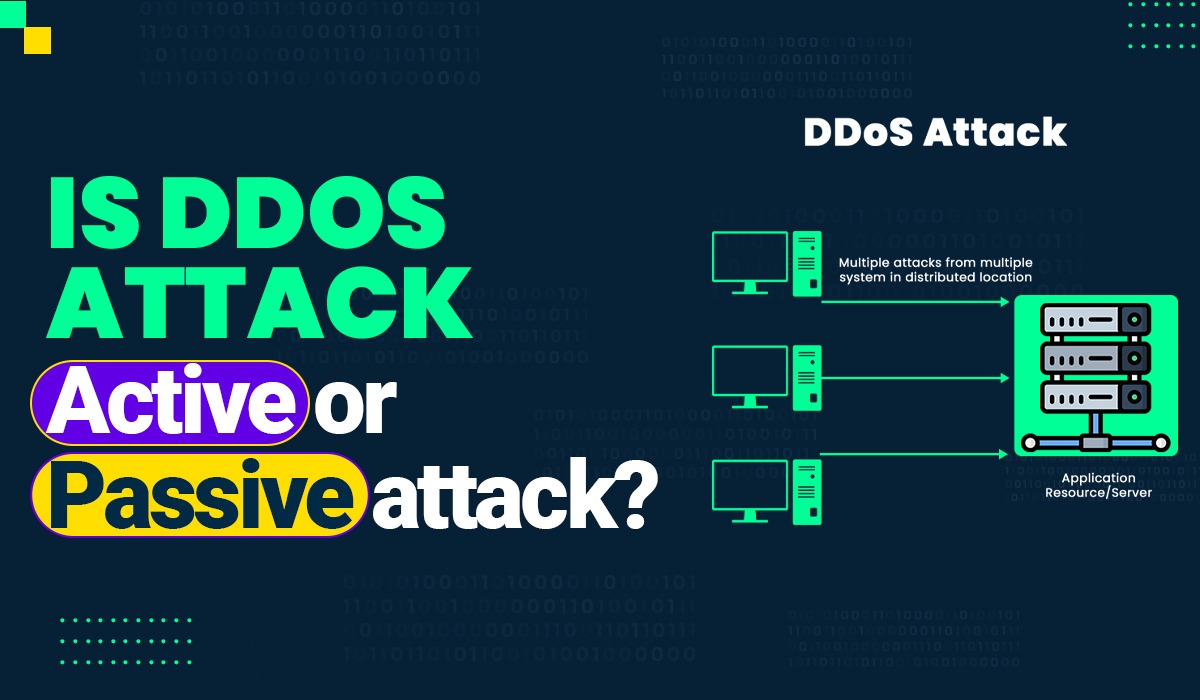
Is DDoS Attack an Active or Passive Attack?
In the realm of cybersecurity, it’s essential to distinguish between the different types of cyberattacks to develop effective defense strategies. Distributed Denial of Service (DDoS) attacks have gained notoriety for their disruptive capabilities, but are they active or passive attacks? This article delves into the intricacies of DDoS attacks, differentiates them from Denial of Service (DoS) attacks, and explores the active and passive aspects of these cyber threats. By the end, you’ll have a comprehensive grasp of how DDoS attacks fit into the spectrum of cyber threats and why understanding their nature is crucial for safeguarding digital assets.
Defining Active and Passive Attacks
Before delving into DDoS attacks, let’s establish a clear understanding of active attack and passive attack:
- Active Attack: An active attack is a deliberate and intentional assault on a system, network, or device with the aim of compromising its security. Active attacks involve intruders actively attempting to breach defenses, gain unauthorized access, steal data, or disrupt services. Examples include malware infections, phishing, and brute-force attacks.
- Passive Attack: In contrast, passive attacks are clandestine and covert in nature. They focus on intercepting, monitoring, or eavesdropping on data without altering it. The goal of passive attacks is to obtain information surreptitiously, often without the target’s knowledge. Examples include sniffing network traffic or wiretapping.
Understanding Denial of Service (DoS) Attacks
Now that we have a foundation in active and passive attacks, let’s explore Denial of Service (DoS) attacks, which serve as a precursor to DDoS attacks:
- Denial of Service (DoS) Attack: A DoS attack is an active attack aimed at disrupting the availability of a targeted system, network, or service. Attackers overwhelm the target with an excessive volume of requests, causing it to become unresponsive or slow down significantly. DoS attacks can be launched by a single source, and they typically exploit vulnerabilities in the target’s infrastructure.
Unveiling Distributed Denial of Service (DDoS) Attacks
Now, let’s shift our focus to Distributed Denial of Service (DDoS) attacks:
- Distributed Denial of Service (DDoS) Attack: DDoS attacks are a variant of DoS attacks but with a significant difference – they involve multiple, distributed sources working in unison to flood a target with an overwhelming volume of requests or traffic. These attacks are orchestrated by a network of compromised devices, often referred to as a botnet. DDoS attacks are highly active and malicious in intent, aiming to cripple the target’s resources and services.
Active Aspects of DDoS Attacks
DDoS attacks exhibit several active characteristics:
- Coordination: DDoS attacks involve the coordination of numerous compromised devices or bots, which are actively controlled by the attacker or a command-and-control server. This coordination is critical for the simultaneous and massive volume of requests that overwhelm the target.
- Traffic Amplification: Attackers employ various techniques to amplify the volume of traffic sent to the target, such as reflection and amplification attacks. This amplification is an active manipulation of network resources, resulting in a deluge of data directed at the target.
- Targeted Impact: DDoS attacks are not indiscriminate; they target specific services, applications, or network resources with the goal of rendering them inaccessible or severely degraded in performance. This selective targeting is a clear indicator of malicious intent.
- Constant Adaptation: Attackers actively adapt their strategies to bypass security measures and mitigation efforts employed by the target. This adaptability is a testament to the ongoing and evolving nature of DDoS attacks.
Passive Aspects of DDoS Attacks
While DDoS attacks are predominantly active, they can also involve passive elements:
- Data Interception: In some cases, DDoS attacks may be accompanied by passive data interception. Attackers may monitor the traffic during an attack to glean sensitive information or identify vulnerabilities for future exploitation. This passive component aims to maximize the attacker’s gains.
- Attack Reconnaissance: Prior to launching a DDoS attack, attackers may passively gather information about the target’s infrastructure, vulnerabilities, and network topology to maximize the impact of the attack. This reconnaissance phase is passive but essential for the success of the active attack.
Differentiating DoS and DDoS Attacks
To see the difference between dos and ddos, consider the following:
- Scale: DoS attacks typically originate from a single source and may disrupt a specific service or resource. DDoS attacks involve multiple sources and can overwhelm an entire network or service due to their scale.
- Coordination: DDoS attacks require extensive coordination among a network of compromised devices, whereas DoS attacks can be executed by an individual or a single device without the need for a coordinated effort.
- Impact: DDoS attacks are more likely to cause widespread and severe disruptions due to their scale and coordinated nature. DoS attacks tend to have a localized impact, affecting a particular resource or service.
FAQs – Frequently asked questions
Q1. Can DDoS attacks lead to data breaches?
A1. DDoS attacks, by themselves, do not breach data confidentiality. However, they can be used as a distraction tactic to divert security personnel’s attention while other attacks, such as data breaches or malware infections, are executed. Therefore, while DDoS attacks are primarily active, they can indirectly contribute to passive data breaches.
Q2. How can organizations defend against DDoS attacks?
A2. Defending against DDoS attacks involves using specialized mitigation solutions, such as traffic scrubbing services and Intrusion Prevention Systems (IPS). Additionally, a well-designed network architecture with redundancy can help absorb and mitigate DDoS traffic. Organizations should also have an incident response plan in place to minimize the impact when an attack occurs.
Q3. Are all DDoS attacks financially motivated?
A3. While some DDoS attacks are financially motivated, others may be carried out for ideological reasons, hacktivism, or even as a form of cyber warfare. DDoS attacks can have various motivations, and not all of them involve financial gain.
Q4. Can DDoS attacks be traced back to their source?
A4. Tracing the source of a DDoS attack can be challenging due to the use of botnets and anonymizing techniques. However, with proper forensic analysis and collaboration with internet service providers (ISPs), it is sometimes possible to identify the origins of an attack, especially if the attack is not well-concealed.
Conclusion
In conclusion, DDoS attacks are unquestionably active attacks, marked by their coordinated, malicious intent to overwhelm and disrupt the targeted systems. While they share similarities with passive attacks in terms of data interception and reconnaissance, their primary purpose is to cause chaos and downtime. Understanding the active and passive elements of DDoS attacks is essential for cybersecurity professionals and organizations seeking to fortify their defenses against these disruptive threats. By staying vigilant and employing robust mitigation strategies, the impact of DDoS attacks can be minimized, ensuring the availability and integrity of critical services and resources.



